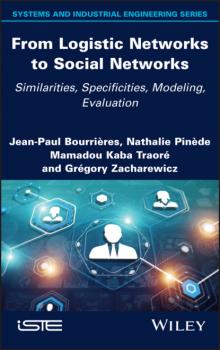ТОП просматриваемых книг сайта:
John Wiley & Sons Limited
Все книги издательства John Wiley & Sons LimitedАннотация
Every parent is concerned when a child is slow to become a mature adult. This is also true for any product designer, regardless of their industry sector. For a product to be mature, it must have an expected level of reliability from the moment it is put into service, and must maintain this level throughout its industrial use.<br /><br />While there have been theoretical and practical advances in reliability from the 1960s to the end of the 1990s, to take into account the effect of maintenance, the maturity of a product is often only partially addressed. Product Maturity 2 fills this gap as much as possible; a difficult exercise given that maturity is a transverse activity in the engineering sciences; it must be present throughout the lifecycle of a product.
Аннотация
As a result of its widespread implementation in economic and social structures, the network concept appears to be a paradigm of the contemporary world. The need for various services – transport, energy, consumption of manufacturing goods, provision of care, information and communication, etc. – draws users into interwoven networks which are meshes of material and immaterial flows. In this context, the user is a consumer of goods and services from industries and administrations, or they themselves are part of the organization (digital social networks).<br /><br />This book examines the invariants that unify networks in their diversity, as well as the specificities that differentiate them. It provides a reading grid that distinguishes a generic level where these systems find a common interpretation, and a specific level where appropriate analytical methods are used. Three case studies from different fields are presented to illustrate the purpose of the book in detail.
Аннотация
Isogeometric analysis (IGA) consists of using the same higher-order and smooth spline functions for the representation of geometry in Computer Aided Design as for the approximation of solution fields in Finite Element Analysis. Now, about fifteen years after its creation, substantial works are being reported in IGA, which make it very competitive in scientific computing.<br /><br />This book provides a contemporary vision of IGA by first discussing the current challenges in achieving a true bridge between design and analysis, then proposing original solutions that answer the issues from an analytical point of view, and, eventually, studying the shape optimization of structures, which is one of the greatest applications of IGA. To handle complex structures, a full analysis-to-optimization framework is developed, based on non-invasive coupling, parallel domain decomposition and immersed geometrical modeling. This seems to be very robust, taking on all of the attractive features of IGA (the design–analysis link, numerical efficiency and natural regularization), giving us the opportunity to explore new types of design.
Аннотация
This book is an original and timeless description of the elasticity of solids, and more particularly of crystals, covering all aspects from theory and elastic constants to experimental moduli. The first part is dedicated to a phenomenological and dimensionless representation of macroscopic crystal elasticity, which allows us to compare all crystals of the same symmetry with the concept of anisotropy and to establish new relations between elastic constants. Multi-scale approaches are then put forward to describe the elasticity at an atomic scale or for polycrystals. The relationship between elasticity and structural or physical properties is illustrated by many experimental data. The second part is entirely devoted to a Lagrangian theory of vibrations and its application to the characterization of elasticity by means of the dynamic resonant method. This unique approach applied to tensioncompression, flexural and torsional tests allows for an accurate determination of elastic moduli of structural and functional crystals, varying from bulk to multi-coated materials
Аннотация
A practical blueprint to rebuilding an education system that is no longer working for its students In From Reopen to Reinvent, distinguished education strategist Michael B. Horn delivers a provocative and eye-opening call to action for the overthrow of an education system that is not working well for any of its students. Grounded in what educators should build in its place to address the challenges that stem from widespread unmet learning needs, the book walks readers through the design of a better path forward. Using time-tested leadership and innovation frameworks like Jobs to Be Done, “Begin with the End,” tools of cooperation, threat-rigidity, and discovery-driven planning, From Reopen to Reinvent offers a prescriptive and holistic approach to the purpose of schooling, the importance of focusing on mastery for each student, and the ideal use of technology. It also provides readers with: A set of processes and ideals that schools should implement to deal with the challenges they presently face A way to transform threats into opportunities using threat-rigidity research A discussion of how the COVID-19 pandemic revealed that schools are not as flexible and equitable as we need them to be Perfect for K-12 educators and parents and school board members involved in the school community, From Reopen to Reinvent is also an essential resource for professionals working in education-related non-profits and state education agencies.
Аннотация
The story begins with a dream – the dream of Africa. Virgin forests, majestic mountains surrounded by savannas, vast plains punctuated with the rhythms of animal life where lions, elephants and giraffes reign as lords of nature, far from civilization – all of us carry such images in our heads, imagining Africa as a timeless Eden untouched by the ravages of modernity. But this Africa has never existed. The more we destroy nature here, the more we fantasize about it in Africa. Along with UNESCO, the WWF and other organizations, we convince ourselves that the African national parks are protecting the last vestiges of a world once untouched and wild. In reality, argues Guillaume Blanc, these organizations are responsible for naturalizing large tracts of the African continent, turning territories into parks and forcibly evicting thousands of people from the lands where they have lived for centuries. Making use of archives and oral histories, Blanc investigates this battle for a phantom Africa and the contradictory claims of nations who destroy nature at home while believing that they are protecting the natural world abroad. In so doing, they enact a new type of colonialism: green colonialism.
Аннотация
Innovation ist ein Wettlauf gegen Mitbewerber und gegen die große überall lauernde Unbekannte, die Überflüssigwerdung. Der Druck im Nacken, auch zu denen an der Spitze zu gehören, die schlaflosen Nächte, wenn man merkt, dass das Innovationsbestreben wieder mal vertagt worden ist, weil es, oberflächlich betrachtet, nicht drängt. Die Angst, dass man eines Morgens aufwacht, der Markt gekippt ist und man von heute auf morgen von einem 10 Personen Start-up aus einer Garage in Wanne Eickel überholt worden ist.<br> Dieses Buch hilft, aus einer anderen Perspektive auf das Thema Innovation zu blicken – und zwar auf allen Hierachieebenen und aus Sicht verschiedener Bereiche, in denen Innovationen eine Rolle spielen. Es beleuchtet, woran Innovation immer noch und immer wieder scheitert, obwohl alle notwendigen Techniken und Budgets aufgefahren wurden. <br> Lena Lührmann zeigt, was auf Bauch- und Kopfebene, zwischenmenschlich und haptisch passiert, wenn Menschen an Innovation denken oder sich damit befassen. Sie möchte so das Bewusstsein bei Führungskräften und Entscheidern in Unternehmen dafür wecken, was ihre Mitarbeiter in Sachen Innovation leisten oder auch nicht. Nur wenn die Leser sich selbst und ihr Unternehmen in dieser Hinsicht verstehen, werden sie in der Lage sein, aus allen wirklich großartigen Techniken die für sie passende herauszufinden. Anhand vieler «Aha-Momente» werden sie die im Buch beschriebenen Problematiken aus der Praxis in ihrem eigenen Unternehmen identifizieren und angehen können.<br> Ziel soll sein:<br> – Innovationsfähigkeitslevel beurteilen,<br> – Innovationchancen erkennen,<br> – Innovation mitmachen,<br> – Innovation beurteilen,<br> – Innovation leben, ganz natürlich aus dem Selbstverständnis des Unternehmens heraus.<br> Jedes Kapitel umfasst drei Aspekte, um sich dem Thema zu nähern: Key Aussagen, Fakten und Lösungen, persönliche Erlebnisse der Autorin.<br>










